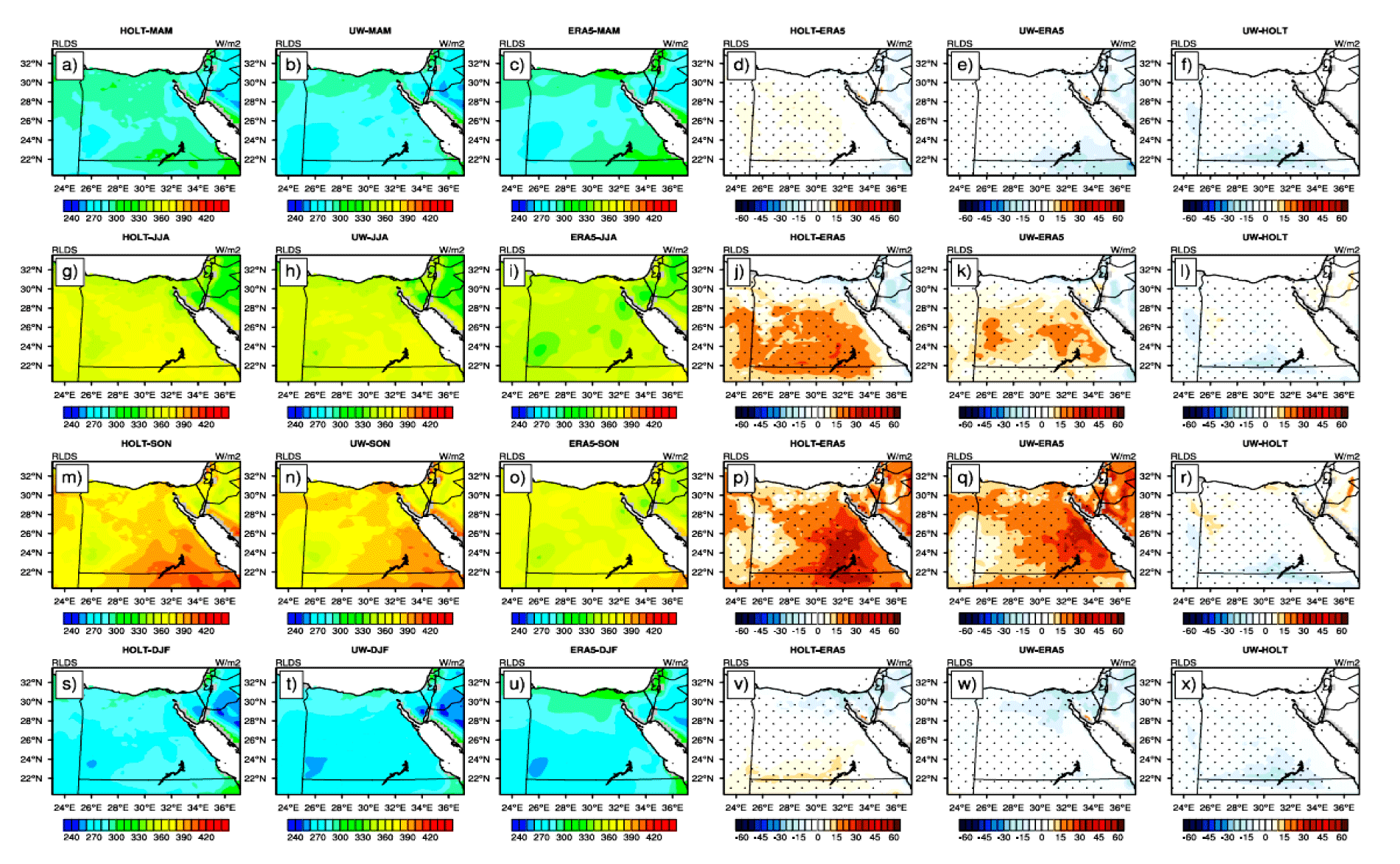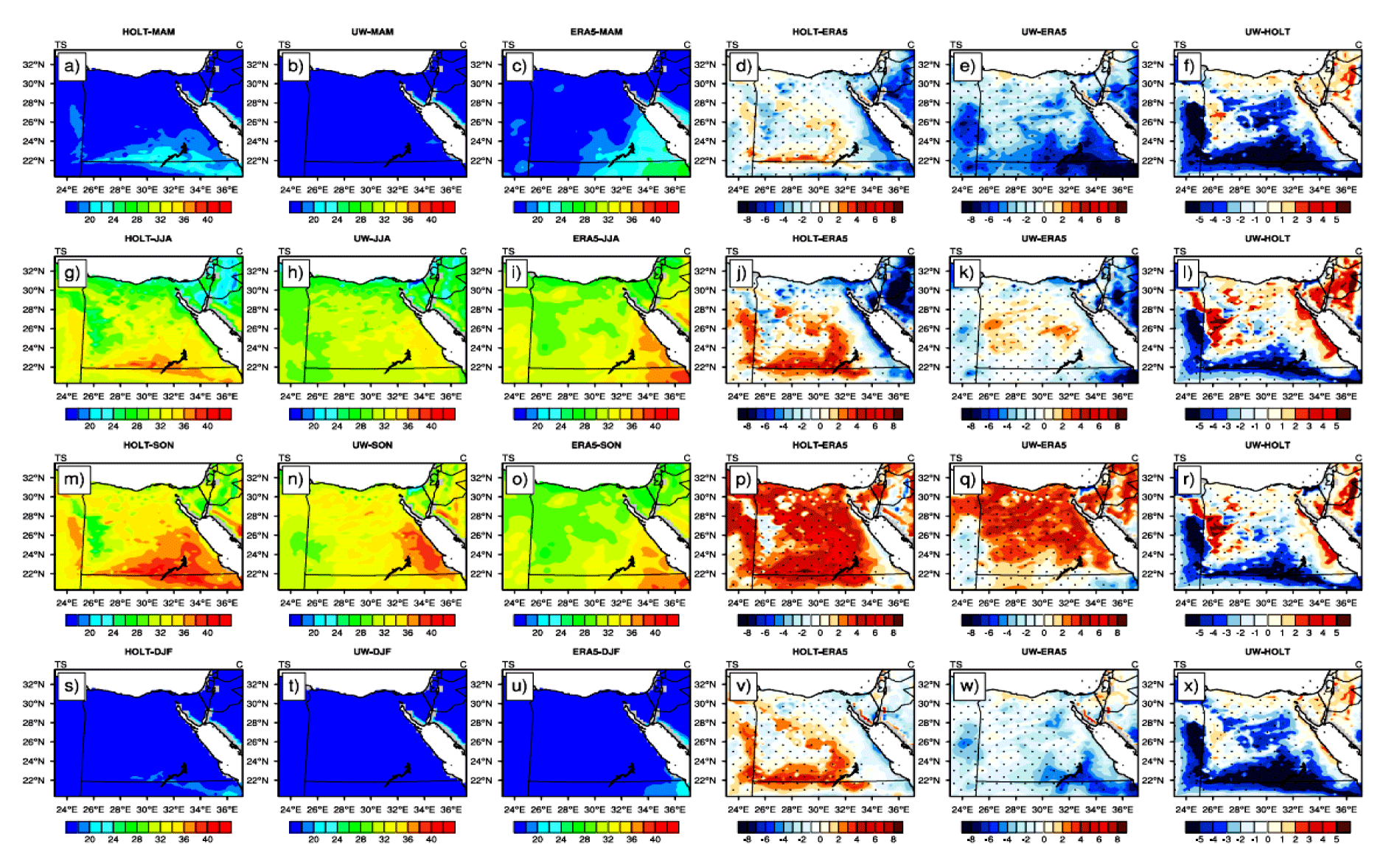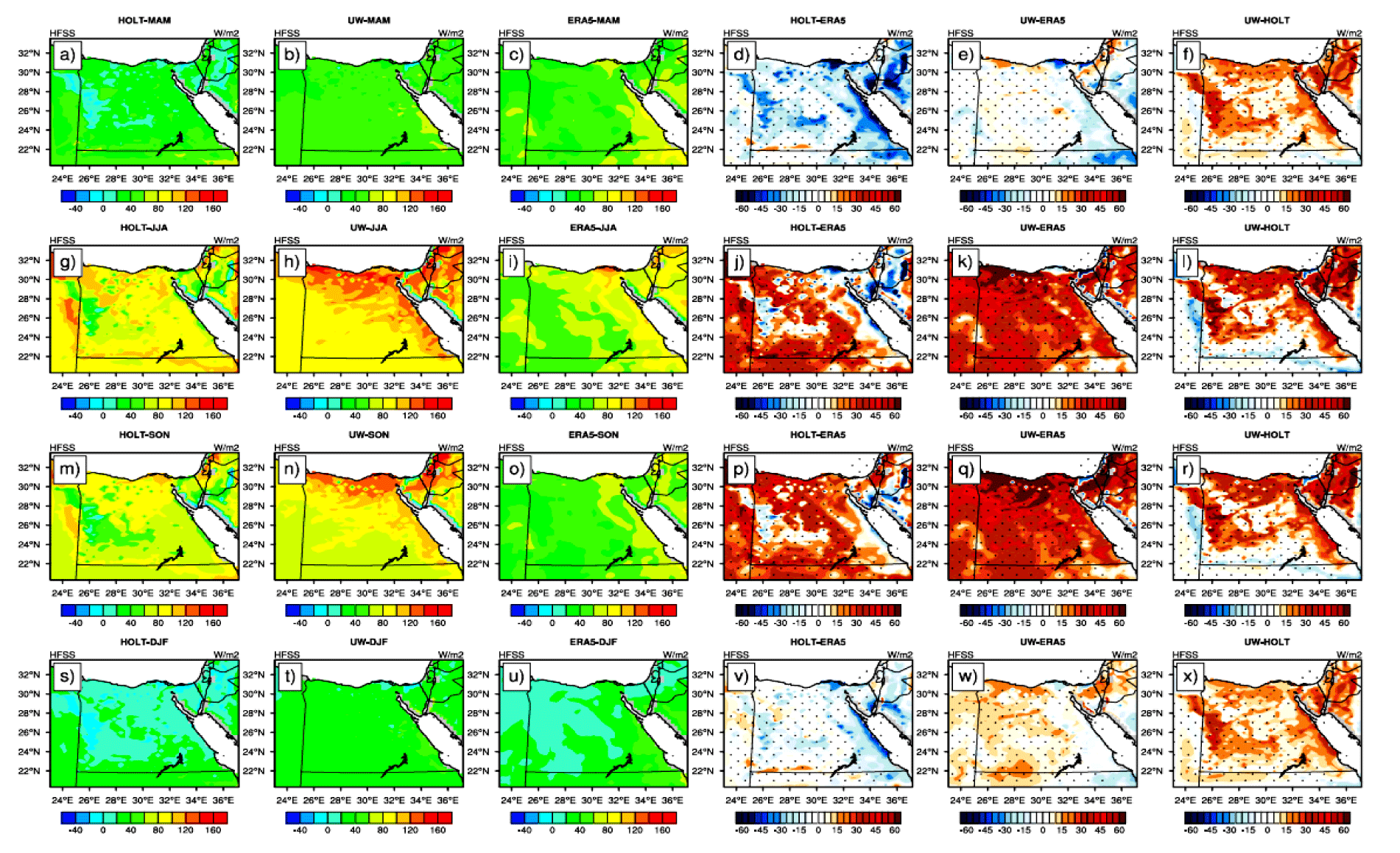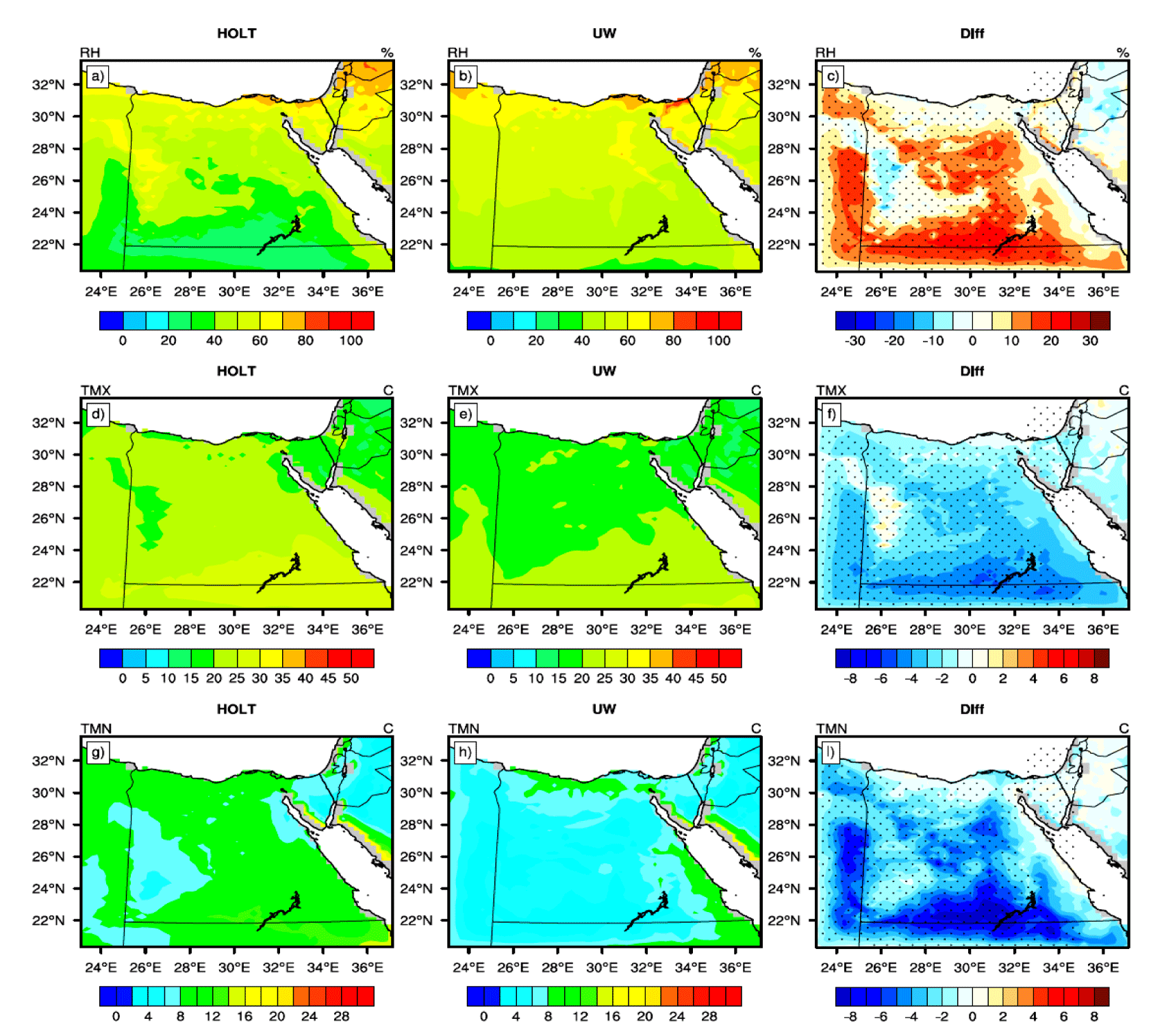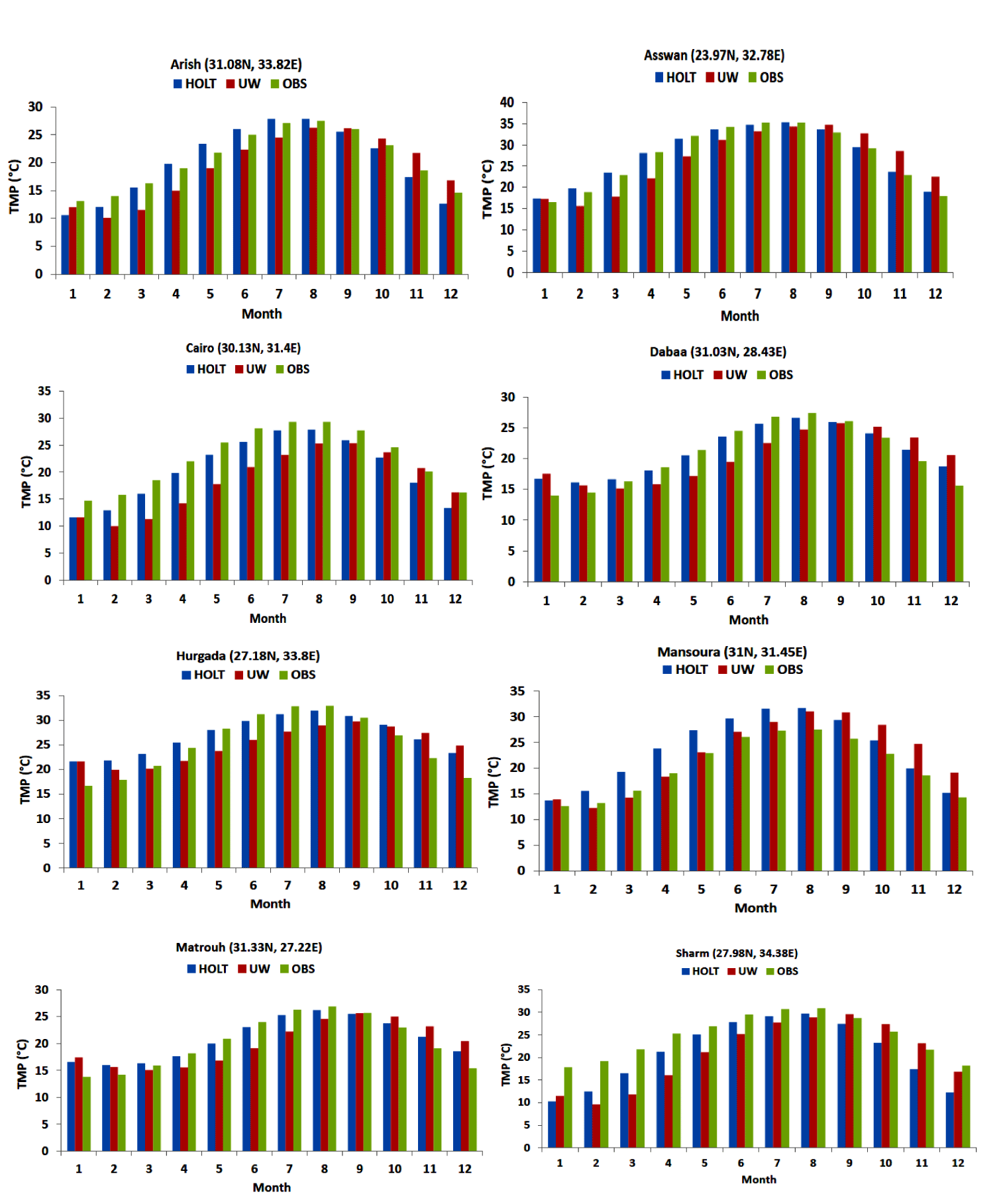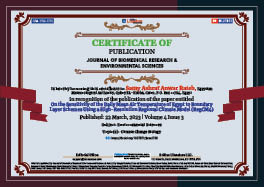Environmental Sciences . 2023 March 22;4(3):474-484. doi: 10.37871/jbres1700.
On the Sensitivity of the Daily Mean Air Temperature of Egypt to Boundary Layer Schemes Using a High-Resolution Regional Climate Model (RegCM4)
Samy A Anwar* and Sally Mahmoud Mostafa
- Boundary layer
- Egypt
- ERA-interim
- ERA5
- Regional climate model
Abstract
Introduction: Boundary layer processes play an important role in controlling the daily mean air temperature through exchange of turbulent fluxes of water and energy between the ground surface and the atmosphere. Therefore, it is important to explore the role of boundary layer parameterization in simulating the daily mean air temperature particularly on a regional scale.
Methods: To accomplish this task, two simulations were conducted to assess the sensitivity of the mean air Temperature (TMP) of Egypt to boundary layer schemes (Holtslag; HOLT and University of Washington; UW) within the framework of the Regional Climate Model (RegCM4). The RegCM4 was downscaled by the ERA-Interim reanalysis of 1.5 degrees with 25 km horizontal grid spacing over the period 1997-2017. Additionally, ERA5 reanalysis product was used as the observational dataset for the variables: the Total Cloud Cover (CLT), surface short and long wave radiation fluxes (RSDS and RLDS), Skin Temperature (TS), surface Wind Speed (WS), Sensible Heat Flux (HFSS) and TMP.
Results: There is no difference between HOLT and UW regarding the CLT and RSDS; while the UW reduces the bias of the RLDS and WS relative to HOLT particularly in the summer and autumn seasons in comparison with ERA5. Furthermore, HOLT and UW schemes showed a considerable impact on the simulated TS. For instance, UW reduces the TS bias relative to HOLT in all seasons but in the spring and winter seasons; UW induces a negative bias more than HOLT. Concerning the HFSS, UW shows a higher bias than HOLT mainly in the summer and autumn seasons. Because of the noted changes of the simulated HFSS and TS, the UW succeeds in reducing the warm bias of the TMP (noted in the HOLT) in all seasons in comparison with the ERA5. With respect to in-situ observations, the HOLT/UW performance varies with the location as well as the month.
Conclusion: The UW scheme can be recommended for future studies concerning the future climate change of Egypt concerning the regional scale. However for a point scale, caution is needed in interpreting the results with respect to the in-situ observations except for Asswan where HOLT can be recommended.
Introduction
Daily mean air temperature is affected by changes of sensible and latent heat fluxes (either from bare soil or vegetated area). Indeed, both fluxes are controlled by vertical fluxes of momentum, heat and mass between the surface and the atmosphere (due to turbulent eddies that occur in the planetary boundary layer; PBL). Also, these eddies play an important role in the global energy budget [1]. Concerning the influence on air quality, the PBL plays an important role of transport and dispersion of pollutants occurs within the lowest part of the atmosphere by turbulent processes as reported by [2]. Importance of the PBL parameterization has been proved in various feedback mechanisms such as snow- albedo feedback [3] and methane feedback [4]. Moreover Baklanov A, et al. [5] reported that there is a gap between PBL physics and its mechanism of action in global/regional climate models.
Broadly speaking, PBL schemes are categorized as non-local and local types of schemes (e.g. [6]). Concerning the non-local type, turbulent fluxes can be expressed by PBL height. On the other hand, vertical gradients of the mean PBL properties are an essential feature of the local scheme. Recently, interaction between the PBL schemes and surface climate has been discussed within the framework of the regional climate models (e.g., RegCM4; [7]). For instance Giorgi F, et al. [7] examined a various combination of radiation, boundary layer and cumulus convection schemes to quantitatively assess the RegCM4 performance concerning the surface air temperature and total surface precipitation over different domains across the globe. Regarding the boundary layer schemes, performance of the RegCM4 has been examined in mid-latitude domains (e.g., continental US).
Güttler I, et al. [8] extensively investigated the role of PBL parameterization (including two boundary layer schemes: Holtslag [9] and University of Washington [10]) in controlling the surface temperature of Europe (as an example) using the Regional Climate Model version 4.2 (RegCM4.2). They found that UW scheme induces a substantial cooling compared to the Holtslag scheme. Additionally, the UW scheme succeeds in reducing the winter warm bias (summer warm bias) over north-eastern Europe (central Europe) by 2°C (3°C) in comparison with the Climate Research Unit product (CRU; [11]). Over the Carpathian region Kalmár T, et al. [12] assessed the performance of the RegCM model (version 4.5) in simulating the total surface precipitation using different combinations of microphysical and PBL schemes. They reported that the UW scheme reduces the wet/dry biases of the total surface precipitation relative to the Holtslag scheme particularly in the summer season. Also, they highlighted an important feature of the UW scheme (a cooling effect due to the reduction of the eddy heat diffusivity in the lower troposphere).
With a particular focus on Egypt, Ali MFA, et al. [2] used the RegCM model version 4.7 (RegCM4.7) to investigate the role of PBL parameterization in simulating a dust storm in December 2010 using a combination of reanalysis products and in-situ observations. To assess the RegCM4 performance, the following variables were examined: surface wind speed, height of the PBL and concentration of Particulate Matter of diameter 10 µm (PM10). They found that the Holtslag scheme outperforms the other schemes in comparison with observations. Such performance can be attributed to the fact that the Holtslag shows a higher wind speed, a thicker PBL, and therefore a higher ventilation index than other schemes.
Anwar SA, et al. [13] and Mostafa SM, et al. [14] used the RegCM4 model to investigate the potential impact of the climate change on the simulated potential evapotranspiration, daily maximum and minimum air temperature of Egypt under different future scenarios. In these literature reviews, the role of PBL parameterization was not examined. Additionally, the sensitivity of Egypt’s surface climate to various boundary layer schemes was not studied within the frame work of the RegCM4. Therefore, the present work aims to address this issue by analyzing the following variables: surface downward short and long wave radiation fluxes, total cloud cover, surface relative humidity, skin temperature, surface wind speed and sensible heat flux. Section 2 describes the materials and methods used in this study; section 3 shows the results of the study. Section 4 provides the discussion and conclusion.
Materials and Methods
In the present study, the Regional Climate Model (RegCM; version 4.7; [7]; hereafter RegCM4) was used. Except for the boundary layer schemes, the RegCM4 domain and simulations were configured following [15]. To address the sensitivity of the daily mean air temperature to the boundary layer schemes, two simulations were conducted. The first simulation used the Holtslag (HOLT) scheme, while the second simulation considered the UW scheme. The reader can refer to [2,7,8] for details of the PBL schemes. It is important to highlight that direct-downscaling was adopted for the two simulations as recommended by [15].
To evaluate the RegCM4 on a regional scale, the fifth generation ECMWF atmospheric reanalysis (ERA5; [16]) was used. Originally, ERA5 is available in 0.25° horizontal grid spacing with 137 vertical levels. Additionally, ERA5 was used to assess the RegCM4 performance concerning the surface energy balance and climate [17,18]. For the purpose of the present study, ERA5 was bilinearly interpolated on the RegCM4 curvilinear grid following [19,20]. For the RegCM4 to be evaluated (regarding the climatological annual cycle of the TMP) on a point scale, station observations of the Egyptian Meteorological Authority (EMA) were used. Based on data availability, eight stations (covering different climate zones of Egypt) were selected. All stations were integrated over the period 1998-2010 (Table 1).
| Table 1: Shows the stations coordinates as well as the climatological monthly values of each month. | ||||||||||||||
| Station | Latitude | Longitude | Jan | Feb | Mar | Apr | May | June | July | Aug | Sep | Oct | Nov | Dec |
| Dabaa | 31.03 | 28.43 | 14 | 14.5 | 16.3 | 18.6 | 21.4 | 24.5 | 26.8 | 27.4 | 26.1 | 23.4 | 19.6 | 15.6 |
| Matrouh | 31.33 | 27.22 | 13.8 | 14.2 | 15.9 | 18.2 | 20.9 | 24 | 26.3 | 26.9 | 25.7 | 23 | 19.1 | 15.4 |
| Cairo | 30.13 | 31.4 | 14.7 | 15.8 | 18.5 | 22 | 25.5 | 28.1 | 29.3 | 29.3 | 27.7 | 24.6 | 20.1 | 16.2 |
| Hurgada | 27.18 | 33.8 | 16.7 | 17.9 | 20.7 | 24.4 | 28.3 | 31.2 | 32.8 | 32.9 | 30.5 | 26.9 | 22.3 | 18.3 |
| Asswan | 23.97 | 32.78 | 16.5 | 18.9 | 22.9 | 28.3 | 32.1 | 34.2 | 35.2 | 35.2 | 32.9 | 29.2 | 22.9 | 18 |
| Arish | 31.08 | 33.82 | 13.1 | 14 | 16.3 | 19 | 21.8 | 25 | 27.1 | 27.5 | 26 | 23.1 | 18.6 | 14.6 |
| Sharm | 27.98 | 34.38 | 17.8 | 19.2 | 21.8 | 25.3 | 26.9 | 29.5 | 30.7 | 30.9 | 28.7 | 25.7 | 21.7 | 18.2 |
| Mansoura | 31 | 31.45 | 12.6 | 13.2 | 15.6 | 19 | 22.9 | 26.1 | 27.3 | 27.5 | 25.7 | 22.8 | 18.6 | 14.3 |
Results
Influence on surface radiation budget and total cloud cover
To understand how the daily mean air temperature is sensitive to the boundary layer scheme, first the surface radiation fluxes (RDSD and RLDS) and Total Cloud Cover (CLT) need to be examined to check if there is an interaction between the boundary layer and the cumulus convection processes. For the aforementioned variables, the following seasons will be considered: March-April-May (MAM), June-July-August (JJA), September-October-November (SON) and December-October-November (DJF). Beginning with the RSDS, the RegCM4 shows a good capability to capture the spatial pattern in comparison with the ERA5 product (Figure S1). In addition, switching between the HOLT and UW schemes does not impose a notable impact on the simulated RSDS. Such behavior can be attributed to the fact that boundary layer parameterization does not control the simulated CLT (Figure S2) and eventually the RSDS.
Like the RSDS, switching between HOLT and UW does not impose a notable impact on the simulated CIT with respect to the ERA5 (Figure S2) suggesting that boundary layer processes do not trigger the cumulus convection. Additionally, HOLT/UW does not able to capture the spatial pattern of the simulated CLT with respect to the ERA5 in all seasons (Figure S2). Such behavior can be seen in the noted biases in all seasons and it can be attributed to the different schemes of the total cloud cover of the RegCM4 and ERA5. Furthermore, it can be observed that HOLT/UW overestimates the CLT (particularly in the JJA season) compared to the other seasons because the JJA season is characterized by a high RSDS along with the strong convection activity of the Emanuel scheme. Lastly, the significant difference between HOLT and UW approaches + 5% in the MAM, SON and DJF seasons (Figure S2) and it varies from + 5 to + 10% in the JJA season (Figure S2).
Concerning the RLDS, the RegCM4 proves its good capability to reproduce the spatial pattern with respect to the ERA5 in all seasons (Figure 1). Over majority of Egypt, HOLT overestimates the RLDS by 5-10 W m-2, while the UW underestimates the UW by 5-15 W m-2 in the MAM season. From a qualitative point of view, the UW decreases the RLDS by 5-20 W m-2 relative to HOLT. Such behavior can be attributed to the fact that UW has a lower RH than HOLT. Because the RegCM4 overestimates the CLT with respect to the ERA5 (Figure S2), HOLT overestimates the RLDS by 10-25 W m-2 while UW succeeds in reducing the bias (to be 10-15 W m-2 approaching 20 W m-2 in some regions). This can be confirmed in figure 2, where UW decreases the RLDS by 5-15 W m-2 relative to HOLT.
Additionally, the RegCM4 bias approaches its maximum range in the SON season because HOLT overestimates the RLDS by 15-45 W m-2. On the other hand, the UW overestimates the RLDS by 15-30 W m-2 approaching 35 W m-2 in some regions. Qualitatively, the UW reduces the RLDS by 5-10 W m-2 approaching 15 W m-2 around Lake Nasser. Lastly in the DJF, the HOLT underestimates the RLDS in the Delta region by 5-15 W m-2 and overestimates by the same order of magnitude around Lake Nasser. On the other hand, the UW succeeds in reducing the RLDS bias particularly around Lake Nasser. Compared to HOLT, the UW decreases the RLDS by 5-20 W m-2 in the JJA season.
Influence on ground temperature and sensible heat flux
As reported in section 1, that boundary layer process plays an important role in controlling the surface climate through turbulent fluxes of water and energy transferred from the ground surface to the atmosphere. Therefore, it is important to analyze the simulated ground temperature (TS; which controls the heat transfer from the earth surface to the adjacent atmospheric layers) and sensible heat flux (HFSS). Figure 2 shows the simulated TS (for HOLT/UW) in comparison with the ERA5. It can be observed from figure 2 that, the RegCM4 is able to reproduce the TS spatial pattern compared to the ERA5 in all seasons. In the MAM, the HOLT underestimates the TS along the north, east coasts and in particular the Red Sea coast (by 2-5°C) and overestimates the TS in the region of 22-26°N (by 1-5°C). On the other hand, the UW induces a cold bias of 2-7°C particularly in the southern sector. From a qualitative point of view, the UW is colder than HOLT by 2-5°C.
In the JJA season, HOLT majorly overestimates the TS by 1-6°C and underestimates along red sea coast and delta region by 2-5°C; while UW succeeds in reducing the warm bias to be the TS by 1-3°C and reduced the noted underestimation to be 1-3°C in comparison with the ERA5. From a qualitative point of view, UW is warmer than HOLT by 2-5°C. Furthermore, the bias of HOLT/UW approaches its maximum value in the SON season as HOLT shows a bias of 3-7°C; while UW shows a bias of 3-6°C overall of Egypt. Also, the significant difference between UW and HOLT ranges from - 4 to + 4°C. Finally in the DJF season, HOLT shows a warm bias of 1-4°C and UW shows a cold bias of 1-3°C. Qualitatively, UW is colder than HOLT by 3-5°C. This noted behavior of the simulated TS can be partially attributed to the fact that UW reduces the RLDS compared to HOLT in all seasons particularly in the JJA and SON seasons (Figure 1). Also, it can be noted that UW amplifies the bias (relative to the HOLT) in comparison with the ERA5. Therefore, TS bias (either from HOLT/UW) propagates to the simulated HFSS.
Figure 3 shows the simulated HFSS with respect to the ERA5. In figure 3, it can be observed that the RegCM4 shows a good ability to reproduce the spatial pattern of the HFSS in all seasons. However, the model bias varies with the season. For instance, the HOLT underestimates the HFSS by 15-35 W m-2 (and by 45-60 W m-2 along the Red Sea coast). On the other hand, the UW overestimates the HFSS by 10-15 W m-2 approaching 20 W m-2 in some regions. Qualitatively, UW has higher HFSS (by 10-35 W m-2) than HOLT. In the JJA and SON seasons the situation is different because HOLT overestimates the HFSS by 15-45 W m-2 approaching 60 W m-2 in some regions; while UW overestimates the HFSS by 25-60 W m-2 over all of Egypt.
From a qualitative point of view, UW is higher than HOLT by 15-35 W m-2 approaching 50 W m-2 in some regions. Lastly in the DJF season, HOLT underestimates the HFSS by 15-25 W m-2 over majority of Egypt, while UW overestimates the HFSS by 10-30 W m-2. Qualitatively, UW is higher than HOLT by ~10-30 W m-2. The noted biases (particularly in the JJA and SON seasons), can be attributed to biases propagating from the TS. Additionally, UW has higher HFSS than HOLT because HOLT overestimates the surface Wind Speed (WS) in all seasons relative to UW in comparison with the ERA5 (Figure S3). This noted behavior of the WS can be attributed to the fact that the HOLT scheme is characterized by excessive vertical transport of heat, moisture, and momentum compared to UW scheme as reported by [7,8]. Therefore, HOLT disperses the HFSS more than UW which explains the high values of the HFSS (as simulated by UW) observed in the JJA and SON seasons.
Influence on surface relative humidity, daily maximum and minimum air temperature
In this section, the potential influence of the HOLT/UW schemes on the surface Relative Humidity (RH), daily Maximum Air Temperature (TMX) and daily Minimum Air Temperature (TMN) is explored (Figure 4). From figure 4, it can be observed that UW induces an increase of the RH relative to the HOLT by 10-30%. Such increase can be attributed to that HOLT scheme causes excessive vertical transfer of moisture leading to low moisture amounts near the surface and excessive moisture near the PBL top as reported by Giorgi F, et al. [7]. As a result, increase of RH leads to inducing of a cooling effect which explains why the UW is colder than HOLT concerning the TMX (by 2-6°C) and TMN (by 2-8°C). This qualitative analysis of the RH, TMX and TMN can explain the biases of the simulated TMP with respect to the ERA5.
Influence on daily mean air temperature (TMP)
Seasonal Climatology: Figure 5 shows the simulated TMP in comparison with the ERA5. From figure 5, it can be noted that the RegCM4 is able to reproduce the spatial pattern of the TMP concerning the ERA5 in all seasons. Additionally, it can be observed that HOLT overestimates the TMP in all seasons particularly in the SON compared to the UW scheme. For instance, the HOLT overestimates the TMP in the MAM season by 1-3°C, while UW underestimates the TMP by 1-2°C approaching 4-5°C around Lake Nasser (Figure 6e). Qualitatively, UW is colder than HOLT by 3-5°C. In the JJA season, the HOLT overestimates the TMP by 1-4°C and UW overestimates the TMP by 1-2°C approaching 3°C in some regions. Additionally, the UW is warmer/colder than HOLT depending on region of study.
In both simulations, the RegCM4 shows its maximum bias in comparison with the ERA5 in the SON season. Yet, UW shows lower bias than HOLT. For instance, the HOLT overestimates the TMP by 3-7°C, while UW overestimates the TMP by 2-4°C approaching 5°C in some regions. From a qualitative point of view, UW is colder than HOLT by 1-4°C. Finally in the DJF season, the HOLT overestimates the TMP by 1-4°C and UW only underestimates the TMP by 1-2°C. Therefore, it can be noted that UW is colder than HOLT by 3-5°C. It can be noted that the simulated TMP (either by HOLT/UW) is affected by changes of the simulated TMX, TMN and RH (Figure 4) as well as the simulated RLDS (Figure 1).
Climatological annual cycle: To further assess the performance of the RegCM4, the climatological annual cycle of the TMP was examined in comparison with the in-situ observations (OBS; Figure 6). From figure 6, it can be noticed that the RegCM4 model is able to reproduce the TMP climatological annual cycle with respect to the OBS. However, the performance varies with location and month. For instance, in Dabaa and Matrouh there is no scheme performs better than the other in January and February. Furthermore, HOLT is closer to the OBS than UW from March to December. In Cairo, both schemes underestimate the TMP in January; while HOLT is closer to OBS than UW from February to August. In addition, UW is closer to OBS than HOLT from September to December. Unlike Cairo, both schemes overestimate the TMP in Hurgada in January, October, November and December. Also, UW is closer to OBS than HOLT from February to March. From April to September, HOLT is closer to OBS than UW.
In Asswan, the situation is quite different because HOLT is closer to OBS than UW for all months. Additionally, UW is closer to OBS than HOLT in January; while UW is closer to the OBS than HOLT from February to December in Arish. In January, both schemes underestimate the TMP in Sharm. From February to August, HOLT is closer to OBS than UW and from September to December, UW is closer to the OBS than HOLT. Lastly in Mansoura, both schemes overestimate the TMP in January, August and September. From February to July, UW is closer to OBS than HOLT. In addition, HOLT is closer to OBS than UW from October to December. This noted behavior of the RegCM4 (across all stations) can be attributed to the fact that local geographic feature (of each station) is not explicitly represented leading to uncertainty in the static data (as an input of the RegCM4). Such uncertainty propagates to the RegCM4 physical parameterization leading to distinctive behavior in each location as reported by Mostafa SM, et al. [14].
Discussion and Conclusion
Boundary layer process plays an important role in controlling the daily mean air temperature through turbulent water and heat fluxes in the PBL. Also, this transport and dispersion of pollutants occurs within the lowest part of the atmosphere is affected by turbulent processes of the PBL [2]. Therefore, role of PBL parameterization in the Regional Climate Model (RCM) is important to constrain the meteorological variables (e.g., temperature) on a regional scale. To address this issue, this role has been examined in various regions across the globe such as Europe [8], Carpathian region [12]. Despite of noted biases, they reported that UW scheme performs better than HOLT concerning the daily mean air temperature and total surface precipitation. Over Egypt, Ali MFA, et al. [2] examined the role of PBL parameterization for the purpose of air quality forecast. They showed that HOLT is the suitable scheme because it is characterized by high wind speed and thick boundary layer height leading to a good records of the Air Quality Index (AQI) compared to other schemes.
However, the sensitivity of the surface climate of Egypt to different boundary layer schemes has not been examined yet. Therefore in this study, the Regional Climate Model (RegCM4) was used to address the sensitivity of the daily mean air temperature of Egypt to two boundary layer schemes with respect to ERA5 reanalysis product and in-situ observations. To accomplish this task, two simulations were conducted over Egypt in the period of 1997-2017. The first simulation adopted the HOLT scheme and the second simulation considered the UW scheme. Both simulations were downscaled by the EIN15 with 25 km horizontal grid spacing. To understand how the daily mean air temperature (TMP) is sensitive to the HOLT/UW schemes, the following variables were examined: RLDS, RSDS, CLT, TS, WS, HFSS, RH, TMX and TMN. The results of the present study are summarized as:
- The UW reduces the RLDS bias compared to the HOLY particularly in the JJA and SON seasons. No difference between the two schemes is noted concerning the RSDS and CLT.
- The UW reduces the TS bias (relative to the HOLT) in all seasons except for the MAM.
- The UW overestimates the HFSS more than the HOLT in all seasons particularly in the JJA and SON.
- Concerning the TMP, the UW succeeds in reducing the RegCM4 bias in all seasons particularly in the DJF.
- In comparison with the OBS, no scheme performs better than the other except for Asswan (where HOLT is closer to OBS than UW for all months).
Despite of noted biases in UW, it outperforms the HOLT in comparison with the ERA5 particularly in the JJA and SON seasons in agreement with the results reported by [12]. Concerning OBS, caution must be taken in interpreting the results except for Asswan (where the HOLT can be recommended). Otherwise, UW can be recommended for future studies concerning the impact of the climate change on the surface climate of Egypt following [13,14]. The current study adopted the default values of the UW parameters, therefore a future study will consider fine-tuning of these parameters and conducting additional sensitivity studies concerning the cumulus convection schemes to possibly simulate the TMP with a reasonable bias either with the ERA5 or with the OBS.
Acknowledgment
Egyptian Meteorological Authority (EMA) is acknowledged for providing the computational power to conduct the RegCM4 simulations and station observations to evaluate the RegCM4 performance in different locations. ECWMF is acknowledged for providing the ERA5 reanalysis product from the web link https://cds.climate.copernicus.eu/ (accessed on 05 February 2023).
Author contributions
Conceptualization, Anwar SA; methodology, Anwar SA.; software, Anwar SA; validation, Anwar SA and Mostafa SM; formal analysis, Anwar SA; investigation, Anwar SA; resources, Anwar SA and Mostafa SM; data curation, Anwar SA and Mostafa SM; writing-original draft preparation, Anwar SA; writing—review and editing, Anwar SA; visualization, Anwar SA and Mostafa SM; supervision, Anwar SA; project administration, Anwar SA. All authors have read and agreed to the published version of the manuscript.
Funding
No funding was received for this study.
Conflicts of Interest
There is no conflict of interest.
References
- Trenberth KE, Fasullo JT, Kiehl J. Earth’s global energy budget. Bull Am Meteor Soc. 2009;90:311-323.
- Ali MFA, Salah Z, Asklany SA, Hassan M, Harhash M, Wahab MMA. A Comparison of three boundary layer schemes for numerical weather prediction. Appl Math Inf Sci. 2020;14(6):1093-1101. doi: 10.18576/amis/140616.
- Winton M. Surface albedo feedback estimates for the AR4 climate models. J Clim. 2006;19:359-365.
- Walter KM, Zimov SA, Chanton JP, Verbyla D, Chapin FS 3rd. Methane bubbling from Siberian thaw lakes as a positive feedback to climate warming. Nature. 2006 Sep 7;443(7107):71-5. doi: 10.1038/nature05040. PMID: 16957728.
- Baklanov A, Grisogono B, Bornstein R, Mahrt L, Zilitinkevich S, Taylor P, Larsen S, Rotach M, Fernando HJS. On the nature, theory, and modeling of atmospheric planetary boundary layers. Bull Am Meteor Soc. 2011;92:123-128.
- Stensrud D. Parameterization schemes: Keys to understanding numerical weather prediction models. Cambridge: Cambridge University Press; 2007. p.459.
- Giorgi F, Coppola E, Solmon F, Mariotti L, Sylla MB, Bi X, Elguindi N, Diro GT, Nair V, Giuliani G, Turuncoglu UU, Cozzini S, Güttler I, O’Brien TA, Tawfik AB, Shalaby A, Zakey AS, Steiner AL, Stordal F, Sloan LC, Branković C. RegCM4: Model description and preliminary tests over multiple CORDEX domains. Clim Res. 2012;52:7-29.
- Güttler I, Branković Č, O’Brien TA, Coppola E, Grisogono B, Giorgi F. Sensitivity of the regional climate model RegCM4.2 to planetary boundary layer parameterisation. Clim Dyn. 2014;43:1753-1772. doi: 10.1007/s00382-013-2003-6.
- Holtslag AAM, Boville BA. Local versus nonlocal boundary layer diffusion in a global model. J Clim. 1993;6:1825-1842.
- Grenier H, Bretherton CS. A moist PBL parameterization for large scale models and its application to subtropical cloud topped marine boundary layers. Mon Weather Rev. 2001;129:357-377.
- Mitchell TD, Jones PD. An improved method of constructing a database of monthly climate observations and associated high- resolution grids. Int J Climatol. 2005;25:693-712.
- Kalmár T, Pieczka I, Pongrácz R. A sensitivity analysis of the different setups of the RegCM4.5 model for the Carpathian region. Int J Climatol. 2021;41(Suppl 1):E1180-E1201. doi: 10.1002/joc.6761.
- Anwar SA, Salah Z, Khaled W, Zakey AS. Projecting the potential evapotranspiration in egypt using a high-resolution Regional Climate Model (RegCM4). Environ Sci Proc. 2022;19:43. doi: 10.3390/ecas2022-12841.
- Mostafa SM, Anwar SA, Zakey AS, Wahab MMA. Bias-correcting the maximum and minimum air temperatures of Egypt using a high-resolution Regional Climate Model (RegCM4). Eng Proc. 2023;31:73. doi: 10.3390/ASEC2022-13852.
- Anwar SA. Influence of direct-downscaling and one-way nesting on daily mean air temperature of Egypt using the RegCM4. 2023a Mar 09;4(3): 338-347. doi: 10.37871/jbres1681.
- Hersbach H, Bell B, Berrisford P, Hirahara S, Horanyi A, Muñoz-Sabater J, Nicolas J, Peubey C, Radu R, Schepers D, Simmons A, Soci C, Abdalla S, Abellan X, Balsamo G, Bechtold P, Biavati G, Bidlot J, Bonavita M, De Chiara G, Dahlgren P, Dee D, Diamantakis M, Dragani R, Flemming J, Forbes R, Fuentes M, Geer A, Haimberger L, Healy S, Hogan RJ, Holm E, Janiskova M, Keeley S, Laloyaux P, Lopez P, Lupu C, Radnoti G, de Rosnay P, Rozum I, Vamborg F, Villaume S, Thépaut JN. The ERA5 global reanalysis. QJR Meteorol Soc. 2020;146:1999-2049.
- Wang X, Chen D, Pang G, Anwar SA, Ou T, Yang M. Effects of cumulus parameterization and land-surface hydrology schemes on Tibetan Plateau climate simulation during the wet season: Insights from the RegCM4 model. Clim Dyn. 2021;57:1853-1879. doi: 10.1007/s00382-021-05781-1.
- Anwar SA, Reboita MS, Llopart M. On the sensitivity of the amazon surface climate to two land-surface hydrology schemes using a high-resolution Regional Climate Model (RegCM4). Int J Climatol. 2022;42(4):2311-2327. doi: 10.1002/joc.7367.
- Anwar SA, Kim Y. On the role of leaf area index parameterization in simulating the terrestrial carbon fluxes of Africa using a regional coupled climate-vegetation model. Eng Proc. 2023;31:9. doi: 10.3390/ASEC2022-13839.
- Anwar SA. Simulating the surface solar irradiance of Africa using a regional climate model: Influence of vegetation-runoff coupled system. Eng Proc. 2023b;31:15. doi: 10.3390/ASEC2022-13814.
Content Alerts
SignUp to our
Content alerts.
 This work is licensed under a Creative Commons Attribution 4.0 International License.
This work is licensed under a Creative Commons Attribution 4.0 International License.





